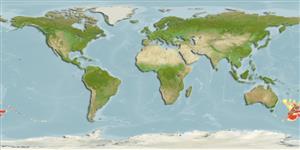Élasmobranches (requins et raies) (sharks and rays) >
Rajiformes (Skates and rays) >
Arhynchobatidae (Softnose skates)
Etymology:
Environment: milieu / climate zone / depth range / distribution range
Écologie
marin bathydémersal; profondeur 170 - 1460 m (Ref. 26346). Deep-water
Southwest Pacific: endemic to New Zealand.
Taille / Poids / Âge
Maturity: Lm ? range ? - ? cm
Max length : 80.0 cm TL mâle / non sexé; (Ref. 26346)
Description synthétique
Clés d'identification | Morphologie | Morphométrie
Dark brown in color (Ref. 26346). Wing tips rounded; snout shorter than most other skates; skin smooth, soft and loose, with band of prickles on hind body and tail (Ref. 26346).
Inhabits the continental slope (Ref. 26346). Oviparous (Ref. 50449). Eggs have horn-like projections on the shell (Ref. 205).
Life cycle and mating behavior
Maturities | Reproduction | Spawnings | Egg(s) | Fecundities | Larves
Oviparous (Ref. 26346). Paired eggs are laid. Embryos feed solely on yolk (Ref. 50449).
McEachran, J.D. and K.A. Dunn, 1998. Phylogenetic analysis of skates, a morphologically conservative clade of elasmobranchs (Chondrichthyes: Rajidae). Copeia 1998(2):271-290. (Ref. 27314)
Statut dans la liste rouge de l'IUCN (Ref. 130435)
Menace pour l'homme
Harmless
Utilisations par l'homme
Outils
Articles particuliers
Télécharger en XML
Sources Internet
Estimates based on models
Preferred temperature (Ref.
123201): 7 - 10.1, mean 8.5 °C (based on 72 cells).
Phylogenetic diversity index (Ref.
82804): PD
50 = 0.5039 [Uniqueness, from 0.5 = low to 2.0 = high].
Bayesian length-weight: a=0.00550 (0.00273 - 0.01106), b=3.10 (2.93 - 3.27), in cm total length, based on LWR estimates for this (Sub)family-body shape (Ref.
93245).
Niveau trophique (Ref.
69278): 3.9 ±0.7 se; based on size and trophs of closest relatives
Résilience (Ref.
120179): Faible, temps minimum de doublement de population : 4,5 à 14 années (Fec assumed to be <100).
Fishing Vulnerability (Ref.
59153): Moderate to high vulnerability (52 of 100).
